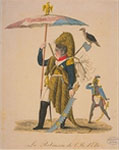
__________
-Jacques-Louis-Constant Lecerf-| Based on the novel (1719-20) by Daniel Defoe (c.1660-1731), the theme of Robinson Crusoe was widely exploited by caricaturists during both of Napoleon's exiles. As for Swift's Gulliver, it is one of the rare examples of great literature to enter popular culture. However, contrary to Gulliver, the French were the ones to make a name for Robinson Crusoe who can also be encountered in German works (Der neue Robinson, catal. exhib. Hanover, p. 168-169, pl. LVI, n° 6.9). Nevertheless, this new Robinson Crusoe is no longer the civilizing hero first conceived by the British writer. He has lost his sheep's skin and has become a tiger, he holds a saw by way of a sceptre and out of his basket protrude writings listing his crimes : Vincennes (The Duke of Enghien's execution), Jaffa (Bonaparte was said to have poisoned his soldiers; cf. R. Wilson, History of the british expedition to Egypt, 1803), Spain, where so many soldiers died, etc. In the background a militarized Man Friday hastens. |
__________
-James Gillray-| Published on June 26, 1803,
by Humphrey, this most famous of caricatures constitutes the first section of a diptych
conceived by Gillray on the subject of Bonaparte/Gulliver, based on the novel by
Jonathan Swift (1726). It is a way of using Napoleon's size, so treasured by
caricturists and lampoonists, and enlarging George III, sovereign of a kingdom of
giants, Brobdingnag. The English text pronounced by the king literally says that
Bonaparte is « one of the most pernicious and most harmful reptiles crawling on the
face of this earth.» |
__________
-James Gillray-| Published
by Humphrey, this caricature initiated a series of themes often used in England, but was
to be taken up in Germany (Ein grosser General und ein kleiner Kaiser), that of
Napoleon, the tiny dwarf also used by lampoonists. In Ten Years of Exile (1821), Mme de
Staël wrote: Based on great literature which had become popular, Gillray, like other caricaturists (Ansell ou West, see Grand-Carteret, n° 119 and 127) drew his ideas from Gulliver<'s travels/I> by Jonathan Swift (1726). This work is an innuendo to the French attempts to land in England in 1803-1804. It contrasts King George III's trust in his navy with the pettiness of the French efforts in the camp of Boulogne. This caricature is the second section of the Gulliver theme used by Gillray. In a previous caricature, the engraver showed the King of Brobdingnag observing Bonaparte the dwarf through a long-view(Grande-Carteret, n° 74, catal. n° 96). |
__________
-Pierre Audouin-| This work recaptures and adapts the composition by
Pierre-Paul Prud’hon's painting (1758-1823) exhibited under that title the 1808
Show (n° 484, Louvre museum). The right hand side of the caricature is the most
changed. Napoleon is contemplating a burning church in front of which soldiers lie dead.
Behind him, the two allegorical figures taken from Prud’hon's painting are coming
to punish him for the crimes whose living symbol he has become. This work is one of the rarest along with Nicolas Philoctetes in Elba /I> et The Final Judgement to be based on great art. |
__________
| This caricature of great style is directly inspired from a painting by Guillaume Guillon-Lethière (1760-1832), Philoctetes in Lemnos, exhibited at the year VI (1798) Show, n° 278 (Paris, Louvre museum). The subject is based on a tragedy by Sophocles. A parallel is drawn between Napoleon abandoned on Elba and Philoctetes. The Emperor's bare arm accounts for the pun in the subtitle « N’a Jamais passé la Manche », which in French can have two meanings, either "always sleeveless" or "never crossed the English channel". This refers to the aborted plan to land in England in 1803. This caricature announces the Robinson Crusoe theme which was to be used during Napoleon's exile in Saint-Helena Island. |
__________
-Henri-Dérard Desalles et Fontallard-| This is one of the rare caricatures which is both inspired from and parodies great art. The authors were inspired by Ugolin's face, as it was painted in the fresco of the Sistine Chapel, when drawing into the "Hell" of Dante's Divine Comedy. Ugolin/Napoleon is therefore taken to hell by a devil, a very common theme at the end of the Empire. In this way, the work takes on a cosmic dimension since the Emperor was likened to the antichrist or to the exterminating angel as foretold by Saint John in the Apocalypse and eliminated before the definite restoration of faith. |
The Anti-Napoléon
Napoleon, body and soul
Ideology
The cosmic struggle
Popular culture
The exiled